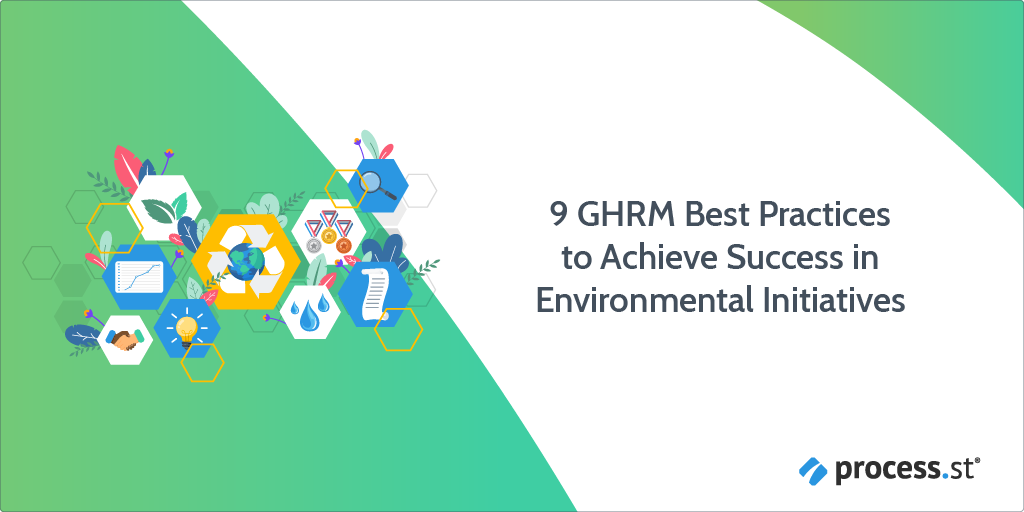 During Sicily’s summer heatwave, Floridia’s famouse snails were baked alive in their shells when temperatures reached an alarming ~120 Fahrenheit (49 Celsius).
During Sicily’s summer heatwave, Floridia’s famouse snails were baked alive in their shells when temperatures reached an alarming ~120 Fahrenheit (49 Celsius).
Wildfires have been blazing elsewhere in Italy, as well as in France, Greece, Australia, California – can anyone remember when there wasn’t a relentless, uncontrollable wildfire somewhere?
2021 was also the year it rained on a Greenland ice cap for the first time and Canada’s last arctic shelf collapsed.
Meanwhile, July 29, 2021 was declared Earth Overshoot Day, meaning the world’s population had already consumed more that year than the planet could regenerate.
(For the record, the US and Canada hit their overshoot day on March 14, while the UK managed to last until May 19. Pat yourselves on the back, folks.)
What does this have to do with HR management? Isn’t green branding more of a marketing problem? Or operations? Or any other department but HR?
Actually, no.
The fact is: No company can go green without employee buy-in. Don’t get me wrong – leadership has to be all-in, too, but if your people aren’t on board with your green initiatives and policies, they’re going to fail and fail hard.
Which is where HR comes in.
In this Process Street post, I’m going to lay out 9 fairly simple best practices that you and your team should be doing if you want to ensure that your pro-environmental behaviors (PEBs) succeed.
What does GHRM even mean?
Green human resource management puts onus on HR professionals to support a company’s sustainability goals. HR’s role here is largely internal – focused on employee behaviors rather than company image – and also behind-the-scenes.
But that’s nothing new. No one notices HR until something goes wrong, am I right?
Don’t fret if this is the first you’re hearing about it, though. GHRM is a relatively new term for a relatively new idea: corporations are just as responsible as private individuals for protecting and preserving the environment.
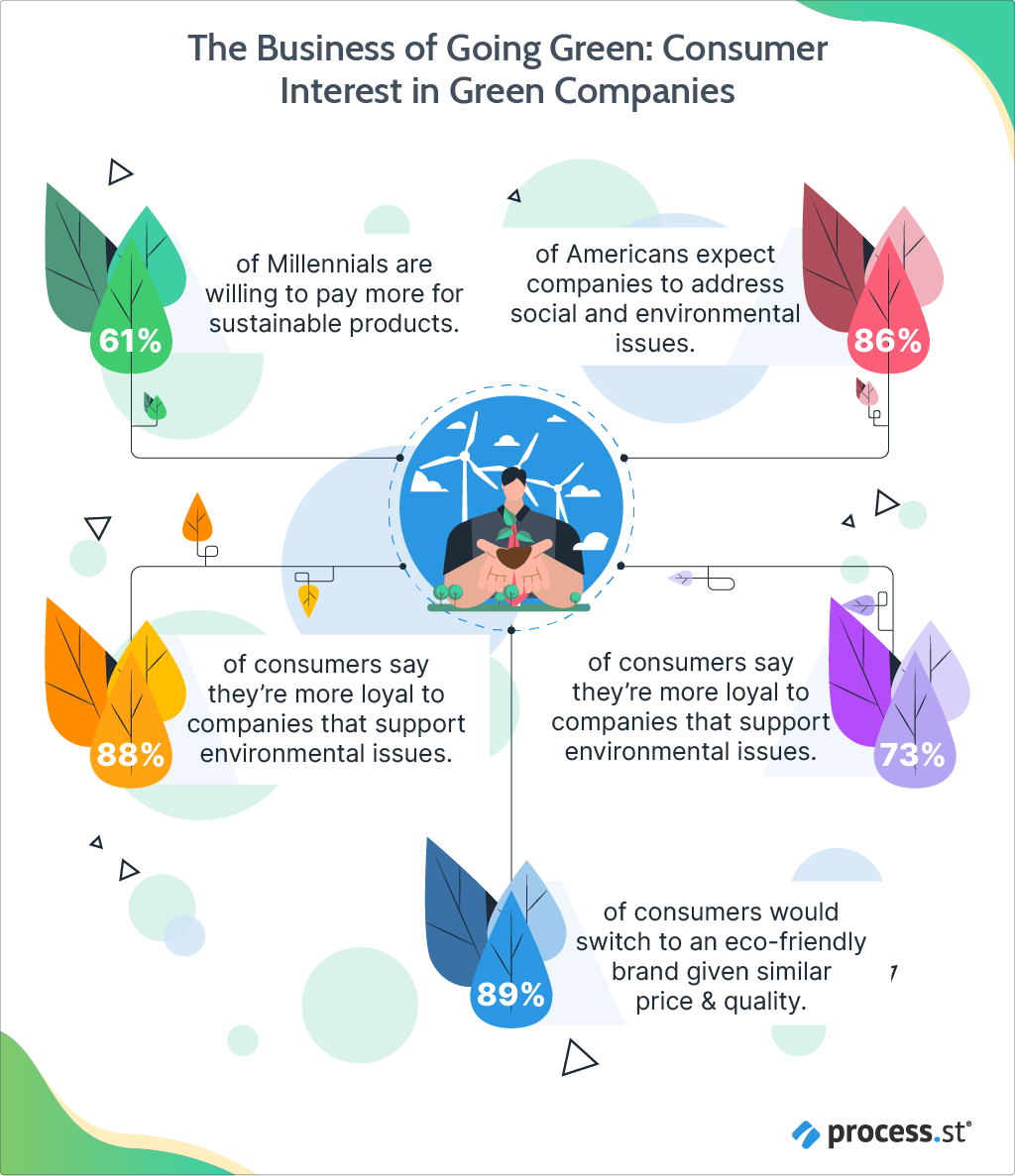
In an era where competition is already pretty fierce, more and more people are using social and environmental responsibility as the deciding factor in the products they buy, the services they use, and the companies they work for.
76% of Millennials would be willing to accept a lower salary to work for a green company, while 61% are willing to pay higher prices for eco-friendly products.
In a previous post, I outlined the 7 indicators of Green human resource management and how going Green improves your employees’ experience at work. In this post, I’m going to concentrate on how it improves your company’s experience in the market.
(Learn more about employee well-being and GHRM in “The Impact of GHRM on Employee Retention and Well-Being.”)
Best practices to boost your GHRM
Needless to say, environmentally speaking, things are pretty ducking bad.
Corporate social responsibility (CSR) is important for environmental sustainability, but it’s essential if you don’t want your company to have a climate crisis, too. Aside from the altruistic benefits of implementing Green HR management to improve your organization’s corporate sustainability, there are indisputable business advantages.
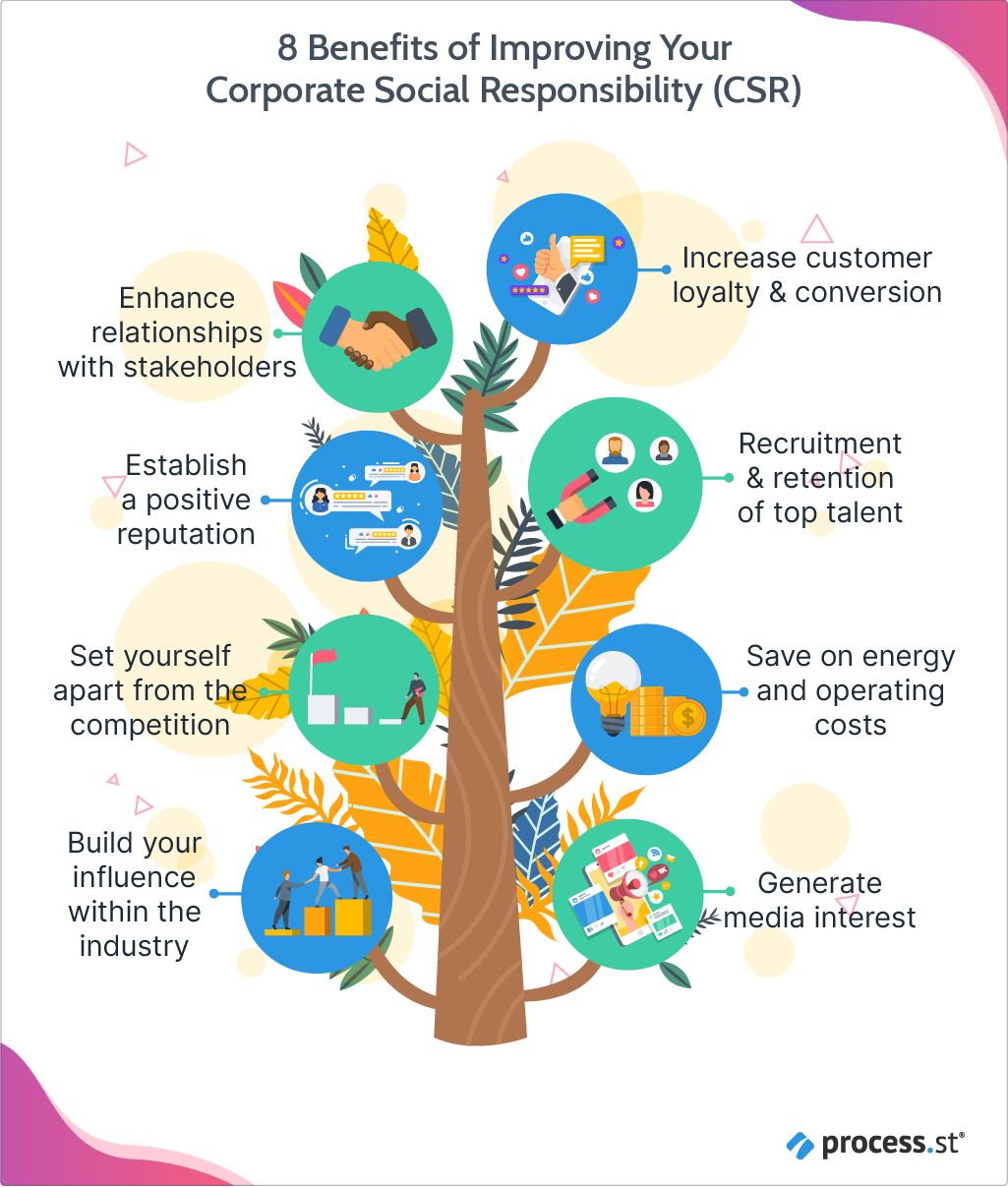
Going Green is a great marketing strategy. Customers prefer Green companies. Job seekers prefer Green companies. And stakeholders prefer a company with high revenue. With an increase in customer loyalty and conversion coupled with a more talented and skilled workforce, your organization will gain more influence, a better reputation, and a lot more public interest. When it comes right down to it, not adding the G to your HRM doesn’t make a lot of sense.
With that in mind, I’ve compiled a list of the 9 essential best practices to give your HR department a foundation to grow your eco-friendly actions.
1. It ain’t easy being green with intentionality
According to Changing Markets Foundation’s survey, “Synthetics Anonymous,” 62% of sustainability claims by fast fashion companies (such as H&M, Louis Vuitton, and Zara) were unsupported by a third party while 59% fell short of the new CMA guidelines. In the case of H&M, their “Conscious Collection” actually contained a higher level of synthetic materials (72%) than their main collection (61%).
This, dear friends, is greenwashing and it’s bad for business (and the environment). As far as consumers are concerned, it indicates that your company is willing to deceive its customers in order to make a quick buck. No one likes to be lied to.
Taking on Green initiatives is not an easy road so you have to do it with deliberate intention. To be sustainable long-term, pro-environmental behaviors (PEBs) need to be worked into the very core of your organization to build a truly Green company from the inside out.
(Learn more about becoming a sustainable business in “How You Can Create a Sustainable Business For Long-Term Success.”)
2. Nurture your employees’ engagement
I said this in the introduction and I’ll say it again: Every environmental initiative you try to put in place will fail unless your employees support it.
The simplest way to get their support is to give them your support. Get them involved in the early stages of the decision-making process.
Get their ideas and feedback on proposed initiatives, practices already in place, and what direction future initiatives should take. What suggestions do they have for making their own spaces more eco-friendly?
Find out what charities and organizations your employees are already involved with and organize donations, sponsorships, or even company-wide volunteer days.
When employees have a sense of ownership over a project or process, they’re automatically more invested in its success.
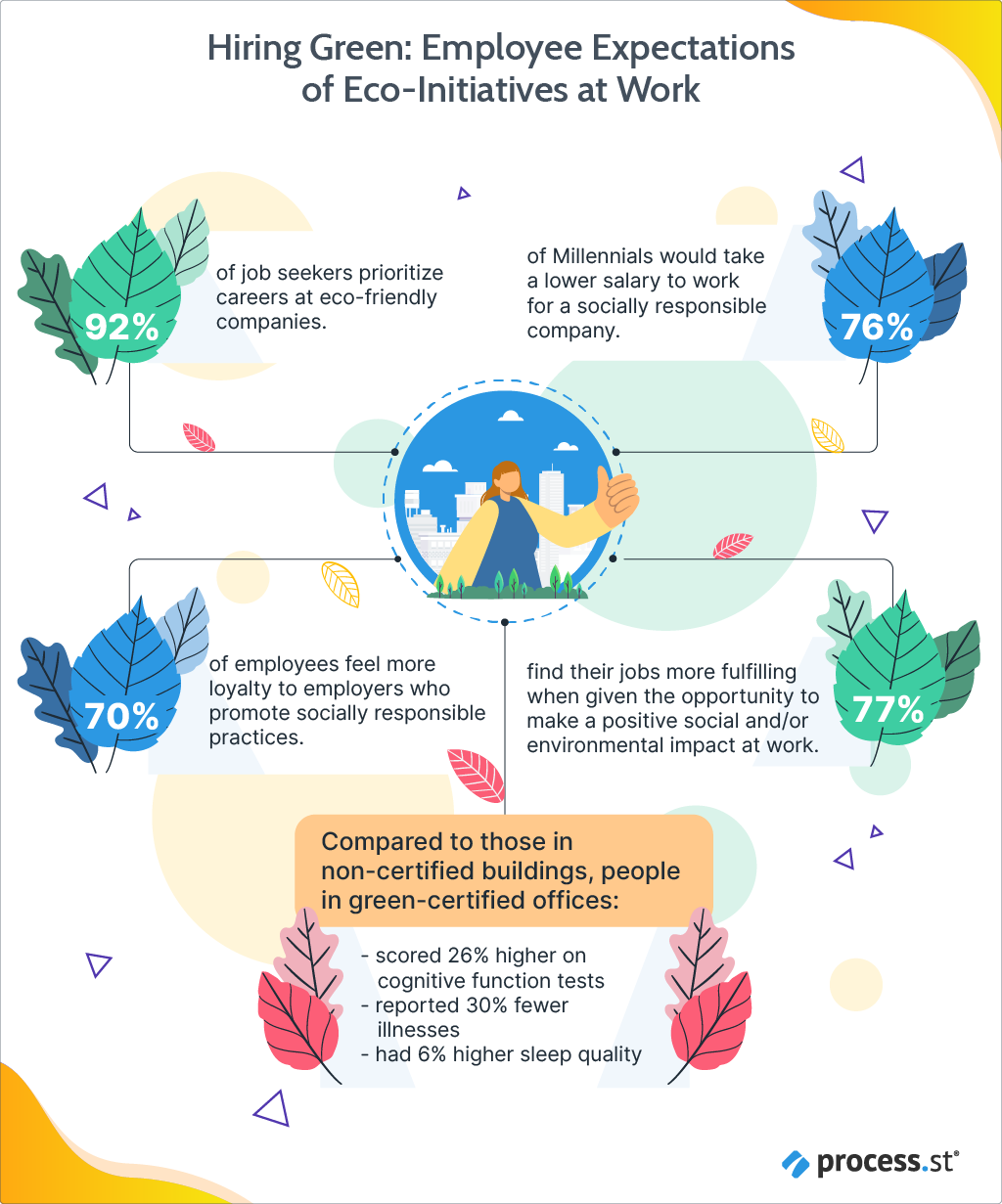
3. Develop policies to support environmental sustainability
Re-evaluate your current policies around recruitment, hiring, and development. Are you actively seeking out eco-friendly job seekers? How sustainable are your recruitment methods?
Digital applications and interviews may not seem like they’ll make a big difference, but they do have an impact on offsetting paper use, transportation emissions, and signaling to prospective employees that you’re committed to sustainability from the get-go.
Tap into the tacit knowledge of industry union representatives, too. There’s a huge overlap between PEBs and health and safety regulations, so your local union rep will be an invaluable resource when it comes to ensuring future policies are environmentally aware.
4. Think green about your internal spaces
This is a no-brainer. Sure, you want your supply chain, manufacturing, and other external operations to be sustainable, but you need to make it a daily habit at work, too.
Use energy-efficient lightbulbs and equipment. Create a paperless office. Reduce the amount of water and other resources consumed in the office. Look into what you can do to create a Green office design for your building. A study done by the World Green Building Council discovered that Green offices improve cognitive ability, performance, loyalty, and workplace satisfaction while reducing absenteeism and hostility among coworkers.
(Learn how to use an environmental management system to support your sustainability goals in “What is Environmental Management? How You Can Implement it Today.”)
5. Establish transparency and accountability for your sustainability goals
Transparency is important when it comes to greenwashing, but also in terms of your organization’s progress on its sustainability goals. Establish an effective communication platform so that employees, clients, and other stakeholders are kept informed and up-to-date on what you’re doing to reach those goals and how well it’s going.
Creating a company-wide newsletter (digital, of course) alerting your employees to volunteer opportunities, new eco-friendly policies, and recent developments will reaffirm their commitment to PEBs and reassure them that their efforts are making a positive difference.
74% of employees report higher job satisfaction when they feel they’re able to make a positive social and/or environmental impact at work.
6. Incentivize pro-environmental behaviors
Self-interest is a great motivator for those employees who feel more ambivalent about environmental issues. According to Cone Communications’ Employee Engagement Study, 87% would engage in PEBs to attain professional growth, while 85% would do it for financial incentives.
Bonuses, gift cards, and public recognition are powerful motivators to get more involved in your organization’s Green initiatives.
In addition, the easier something is, the more likely people are to do it. Motivation alone isn’t always enough to get everyone using eco-friendly actions. Cost, lack of information, or lack of facilities can all act as barriers for sustainable action, even for the most environmentally conscious person. For example, littering is more likely when trashcans aren’t available, public transport is impractical if service is too unreliable, and organic produce is often unavailable, or too costly for everyone to have access.
Establish a cycle-to-work campaign by loaning bicycles to employees, or offer “carbon credit cards” for achieving Green milestones. You could even provide PTO for time employees spend volunteering.
As with any aspect of people management, employee acknowledgment is vital to reinforcing behaviors.

7. Innovate organically
Recycling paper and plastic bottles are obvious options, but be willing to think outside the box. Both Google and Intel have onsite gardens where employees can grow organic vegetables that will later be used in the campus cafeterias and restaurants.
This again will rely on communication and transparency with your employees, particularly if you’ve been successful in recruiting eco-savvy talent. Find out what experiences and projects they bring to the table and learn from them.
What if is the single most powerful phrase in existence. Use it.
(Learn how to stay compliant while you innovate in “How To Lead Innovation When Implementing Compliance: 7 Ways.”)
8. Measure the success of your environmental actions
Establish goals. These should be challenging, achievable, and, most importantly, measurable. Naturally, there will be public, company-wide sustainability goals, but there should also be individual, internal goals for teams, employees, and managers to achieve.
Incorporate these into your regular performance review – or even conduct separate sustainability reviews – and use those reviews to determine what’s working and what’s not. As a side bonus, you’ll also discover who’s working and who’s not.
Essentially, though, people like concrete, tangible results. They like to know they’re making progress, that their actions have purpose, and that their skills and abilities are valued. Including PEBs in performance reviews is another way you can make those behaviors a habitual part of the day-to-day running of your organization.
(Learn more about creating sustainability reports in “GRI Standards for Sustainability Reporting: What They Are and Why They Matter.”)
9. Graft Green practices into your company culture
This is not so much a best practice as a culmination of the previous eight best practices. While the COO and other money-minded folk are hard coding sustainability into the business plan, your team needs to do the same with the company culture.
Sustainability needs to be an integral part of everything that happens in your organization, so much so that people differentiate between pro-environmental behaviors and “the way we do things here.”
Each of the previous eight practices will help achieve that mindset in your organization. While some aspects of company culture do “just happen” on their own, it does take intentionality and effort to cultivate those aspects and focus them in the desired directions.
This means that leadership needs to model the desired behaviors, too. If you’re offering an incentive for employees who purchase hybrid or low-emission vehicles, but your CEO pulls up in a gas-guzzling SUV every day, there’s going to be a disconnect between your eco-ambitions and employee commitment.
Reaping the rewards of GHRM
Change is hard and most people don’t like it. No matter what you do or how you frame it, you’re going to come up against resistance, and there will be teething problems. You’re very likely to find yourself in a two-steps-forward/one-step-back scenario. Many a manager has pulled the plug on a new initiative too soon due to initial resistance, but if you’re able to knuckle down, the seeds of your efforts will certainly sprout.
While it is crucial that your Green initiatives are grown from the bottom-up, you also need top-down support, too. During these early stages, it’s important that leadership and senior managers actively support your Green management policies. Seeing anything through to fruition is a process, and, like most processes, everyone has their part to play.
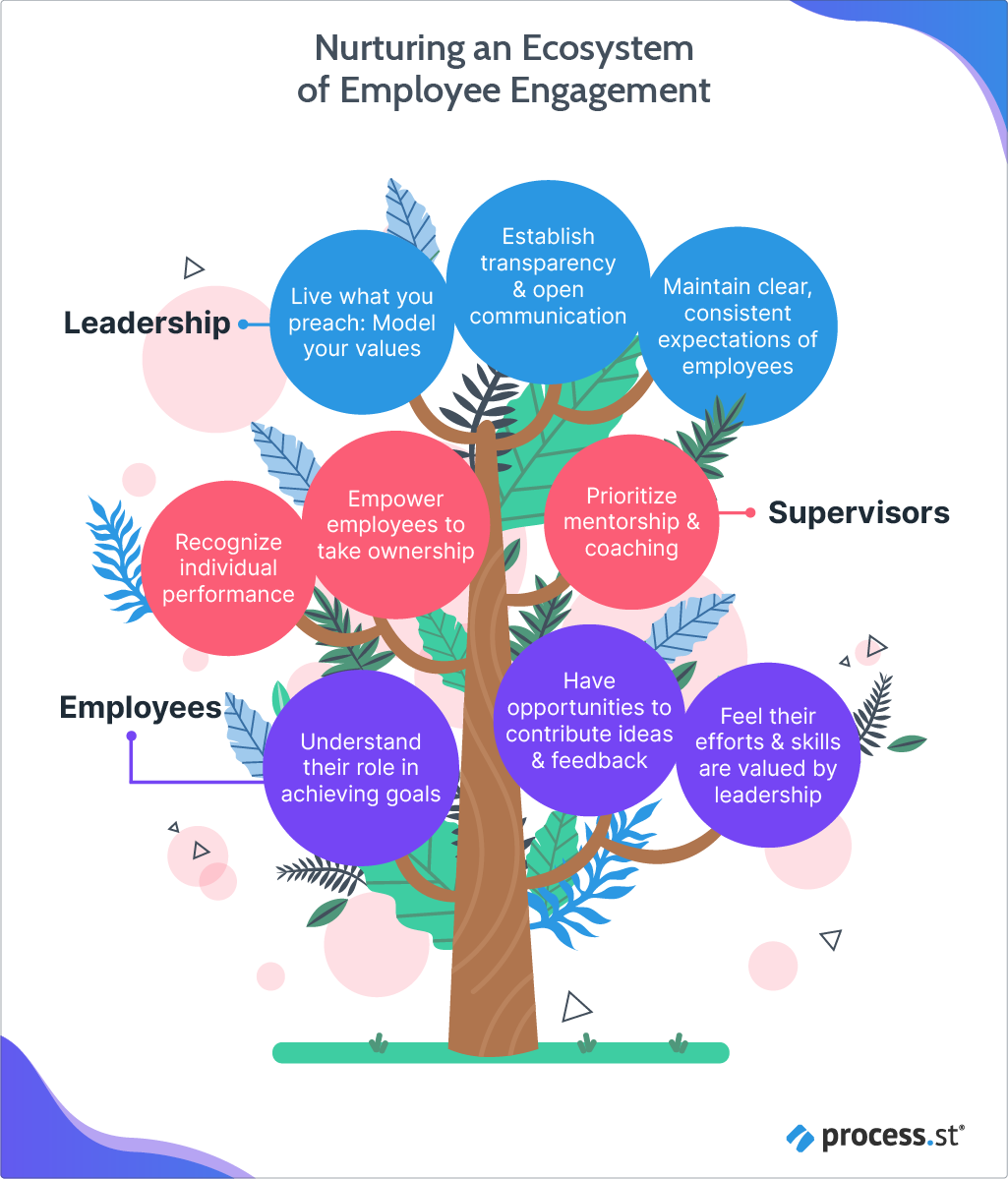
Leadership needs to set clear expectations and be able to communicate them effectively throughout your organization. Managers and supervisors need to prioritize coaching and training so employees have the skills to meet those expectations. Employees need to be able to understand what’s expected of them, have the resources to fulfill those expectations, and, of course, feel like their contributions are valued.
Start small, be realistic about what you hope to achieve with your Green initiatives, and keep those communication channels open. The more you involve employees in the beginning phases, the easier making progress will be. By doing this, employees won’t feel like the new initiatives are being done to them but by them.
While those are two very small words, they carry a lot of weight when it comes to morale, commitment, and loyalty.
How do you get your employees involved with Green initiatives at your organization? Let us know in the comments!







Leks Drakos
Leks Drakos, Ph.D. is a rogue academic with a PhD from the University of Kent (Paris and Canterbury). Research interests include HR, DEIA, contemporary culture, post-apocalyptica, and monster studies. Twitter: @leksikality [he/him]